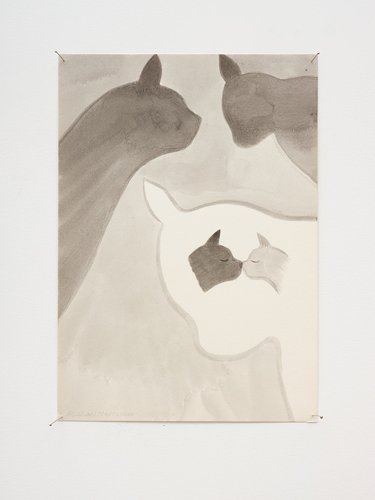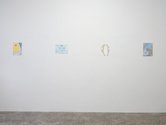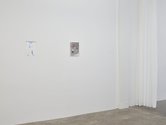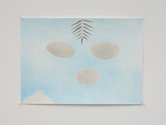John Hurrell – 26 October, 2023
If we were to create a thought experiment, could we imagine Harrison creating a doggy version of these images? While dogs seem more social animals than cats (more community-oriented, say—and with very different temperaments and indicators of affection), for canine twosomes, is mutual devotion and canine love part of that scenario? It is an open question.
Amorous and in their minds, recklessly forward, cats make up most of the delicate and intimate pencil, watercolour and acrylic wash paintings in this new Michael Harrison show, constantly pining and sometimes horny felines that are averse to being solitary, celibate and lonely. There is an amusing pervading assumption that cats are very much like humans, but that they have a vivid internal mental life revolving around feline desire for feline love. Feline passion rules, but not tedious feline small-talk. Never inanity, and never aggression.
There are also no hints of complications like states of coyness or bashfulness that might hide what really is cunningly controlled lust. In Harrison‘s world, most cat couples here feature a common ‘loving’ interiority. Devoted loyalty and affection is a salient theme, rather than beastly rutting.
Besides referencing our ubiquitous non-human mammalian companions, Harrison presents a sign system self-consciously aware of its own visual and emotional dynamic. Naturally these harmonious and curvaceous symbols are totally different in mood from realities we might experience such as the screeching harsh aural ‘serenading’ that often keep us painfully awake at night. Cat psychology (and courting ‘musical’ aesthetic) is a universe baffling to most humans, even if we happen to be their devoted owners and carers.
Many of these understated sensitive compositions are symmetrical, with an emphasis on negative shape, mid-toned silhouetted profile, and awareness of paper edge. Harrison is skilled at gradually ramping up pigment levels, so that initially flat diluted forms slyly gain a restrained bodily materiality and discreet allusion to volume.
If we were to create a thought experiment, could we imagine Harrison creating a doggy version of these images? While dogs seem more social animals than cats (more community-oriented, say—and with very different temperaments and indicators of affection), for canine twosomes, is mutual devotion and canine love part of that scenario? It is an open question. However, it is possible Harrison’s seemingly depicted affection for women on other occasions carries over into his fondness for felines, as a speculation about their bonding—a little of what Ruskin called ‘the pathetic fallacy.’
Other than pondering symbols of companionship and intimacy, I also wonder whether Harrison is exploiting irony, if he is really considering the negative meaning of being ‘catty’, or furtively making vulgar ‘pussy’ jokes—counter-productive ideas it seems sensible to swiftly reject; especially if you choose to factor in intentionality. Such cynical interpretations don’t seem feasible for such an unabashedly and consistently romantic artist.
Shifting to human subjectivities even more directly, Harrison’s single image of a young woman in love shows her blue figure standing between two blinding auras emitted by persons invisible, enraptured and captured by both. Maybe caught in a dazzling pair of opposing unrepresentable desires; or perhaps terror and ecstasy combined?
Lucky cats experience no such conflict. For them it is all plain-sailing and uncomplicated: a blissful stairway to cuddly furry heaven.
John Hurrell













 Advertising in this column
Advertising in this column Two Rooms presents a program of residencies and projects
Two Rooms presents a program of residencies and projects



This Discussion has 0 comments.
Comment
Participate
Register to Participate.
Sign in
Sign in to an existing account.